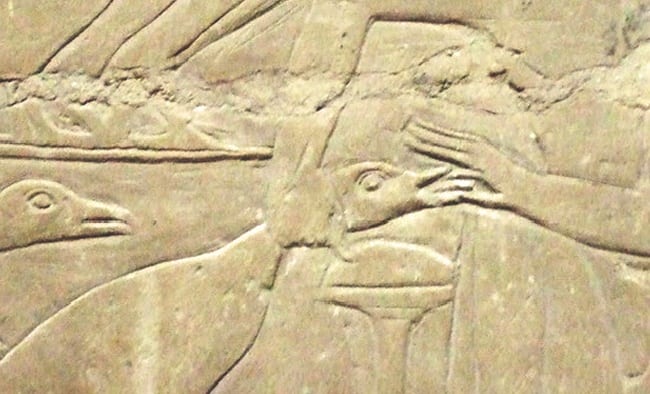Foie Gras goose liver pate is considered a French delicacy – an attribute of luxurious life; in France it is traditionally served at the Christmas table.
The French are not the authors of the foie gras recipe, although thanks to them the dish has become widespread and cult. The Egyptians were the first to cook and serve the goose liver 4 thousand years ago. They noticed that the livers of nomadic geese and ducks are much tastier, and this is all because they heavily feed on figs when they stop on flights. To have such a delicacy always at hand, the Egyptians began to forcibly overfeed poultry with figs – a forced diet for several weeks made the livers of geese and ducks juicy, fatty and soft.
The process of force feeding a bird is called gawage. In some countries, such treatment of animals is prohibited and punishable by law, but lovers of foie gras do not see force-feeding as any threat. The birds themselves do not experience discomfort, but simply eat deliciously and recover quickly. The process of liver enlargement is considered quite natural and reversible, migratory birds also eat a lot, recuperating, and their liver also enlarges several times.
This technology was spied on by the Jews who lived in Egypt. They pursued their goals in such fattening: because of the prohibition of pork fat and butter, it was profitable for them to raise fat, fed poultry, which was just allowed to eat. The liver of birds was considered non-kosher and was marketed profitably. The Jews transferred the technology to Rome, and the tender pâté migrated to their lavish tables.
Goose liver is softer and more creamy than duck liver with a musky aroma and specific taste. The production of duck liver is more profitable today, so foie gras is mainly made from it.
Foie Gras is French for “fatty liver”. But the word liver in the languages of the Romance group, which also includes French, means the very figs with which it is customary to feed birds. Today, however, birds are fed with boiled corn, artificial vitamins, soybeans and special feed.
For the first time, goose pate appeared in the 4th century, but the recipes of that time are still unknown for certain. The first recipes that have survived to this day date from the 17th and 18th centuries and were described in French cookbooks.
In the 19th century, foie gras became a fashionable dish of the French nobility, and variations in the preparation of pate began to appear. Until now, many restaurants prefer to cook foie gras in their own way.
France is the largest producer and consumer of foie gras in the world. Pate is also popular in Hungary, Spain, Belgium, USA and Poland. But in Israel this dish is prohibited, as in Argentina, Norway and Switzerland.
In different regions of France, foie gras also differ in color, texture and taste. For example, in Toulouse it is an ivory-colored pâté, in Strasbourg it is pink and hard. In Alsace, there is a whole cult of foie gras – a special breed of geese is grown there, the liver weight of which reaches 1200 grams.
The benefits of foie gras
As a meat product, foie gras is considered a very healthy dish. There are many unsaturated fatty acids in the liver, which can equalize the level of cholesterol in the human blood and nourish cells, improving the functioning of all body systems.
The calorie content of goose liver is 412 kcal per 100 grams of product. Despite the high fat content, the poultry liver contains 2 times more unsaturated fatty acids than butter, and 2 times less saturated fatty acids.
In addition to fats, a relatively large amount of protein, duck and goose livers contain vitamins of group B, A, C, PP, calcium, phosphorus, iron, magnesium, manganese. The use of foie gras is useful for vascular and heart problems.
Culinary variety
There are several types of foie gras sold in stores. Raw liver can be cooked to your liking, but this should be done right away while it is fresh. Semi-cooked liver also requires immediate finishing and serving. Pasteurized liver is ready to eat and can be stored in the refrigerator for several months. Canned sterilized liver can be stored for a very long time, but the taste is completely far from the real French pâté.
The most beneficial is considered to be pure, whole poultry liver without any additives. It is sold raw, semi-cooked and cooked.
Foie gras is popular with the addition of exquisite ingredients – truffles, elite alcohol. From the liver itself, mousses, parfaits, pates, terrines, galantines, medallions are prepared – all using different technological processes. For the mousse, beat the liver with cream, egg whites and alcohol until the mass becomes fluffy. Terrine is baked by mixing several types of liver, including pork and beef.
To make foie gras, you need the freshest liver. Peeled from films and thinly sliced, it is fried in olive oil and butter. It is ideal if the liver remains soft and juicy on the inside, and has a hard golden crust on the outside. Despite the seeming simplicity, rarely does anyone manage to perfectly fry duck or goose liver.
Fried liver is served with all sorts of sauces as a main dish and as an ingredient in a multi-component dish. Foie gras combines mushrooms, chestnuts, fruits, berries, nuts, spices.
Another way of making pate is the liver of a bird is marinated in cognac and spices, truffles and Madeira are added to it and ground to a delicate pate, which is prepared in a water bath. It turns out an airy snack, which is cut and served with toast, fruit and salad greens.
Foie gras does not tolerate the neighborhood of sour young wines; heavy sweetish liqueur wine or champagne will suit it.










